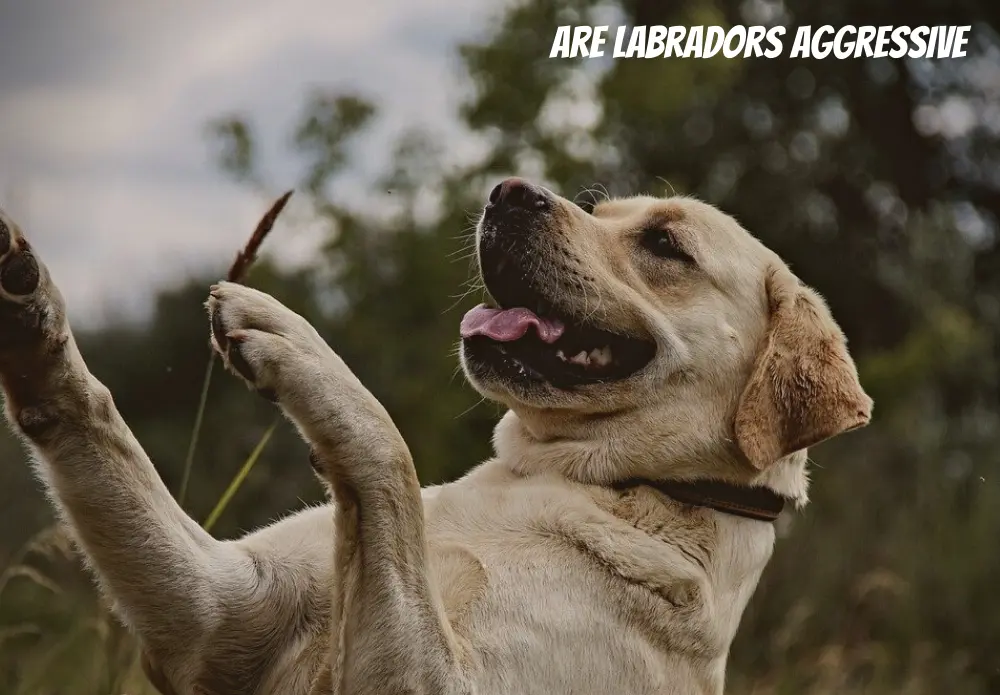Being the owner of an aggressive dog is stressful and perhaps hazardous. We’ll examine today whether Labradors ever display aggression. We’ll discuss the origins and symptoms of canine aggression. And advise what to do if you believe your Labrador might be aggressive.
For the past five years, the Labrador Retriever has been the most popular breed in the U.S. It is obvious that Labradors make excellent pets because they constantly rank first among Americans’ favorite canines.
However, some Labrador owners continue to be concerned about their dogs’ temperament, some even asking themselves, “Are Labs aggressive?” Since Labradors are large dogs, an aggressive one could be challenging to control.
Are Labradors Aggressive?
In general, labradors are not aggressive. A 2008 study discovered that they were among the least violent breeds of the canine participants.
However, there is a slight difference in how you respond to “Can Labradors Be Aggressive?” As with any canine, a person’s personality will be influenced by their life experiences and inherited traits from their parents. Therefore, even while it is possible to encounter a violent Labrador, remember that this is not a trait of the breed.
Aggression was never a feature favored in the Labrador breed, as seen by its history. Let’s quickly examine Labrador’s ancestry.
Labrador Temperament
Fortunately, Labradors are not typically known as aggressive dogs. They are renowned for having a calm, kind, and tolerant demeanor, so they make such a wonderful family dog.
However, behavioral problems might occur in some Labradors. Like people, each dog has a unique personality, and how it has been raised will impact their behavior.
The history of the Labrador
The St. Johns Water canines were working canines that were the forerunners of the Labrador. Their primary responsibility was to help fishermen. They assisted the fisherman in retrieving nets and ropes in addition to assisting them in catching fish. In their native Newfoundland, these dogs were bred expressly to survive the frigid temperatures encountered while working on the water.
These dogs’ superb temperaments, excellent swimming skills, and work ethics delighted English noblemen who had visited Newfoundland and studied them. As a result, some St. Johns Water Dogs were imported to England in the early 1800s and raised as shooting dogs. The modern-day Labrador first appeared around this time.
Sadly, the St. Johns Water Dog has since disappeared. However, there are still traces of these excellent dogs in modern Labradors. This quick examination of the Labrador’s history and pedigree shows that violence was never a trait that was fostered or called for in the breed.
What Could Be Causing Your Lab’s Aggression?
A scared puppy is aggressive. An aggressive pup retreats and hides before attacking, sometimes with a low growl. An attack is typically the last option if they haven’t been able to dodge you.
Being Protective
Your Lab may have kept some memorabilia and placed them close to its resting space. It makes sense that labs can be trained for hunting and retrieving because they enjoy collecting things.
If you choose a specific object, such as a dish of food or a set of keys, your Lab will become agitated. The dog may begin growling and aggressively barking at you. This may indicate that you have let the dog down.
Training Issues with behavior
Dogs can benefit from having good manners. When improperly socialized, it may exhibit aggression toward people and other pets. During your walks, your Lab can start barking at other dogs, or she might not like visitors in the house.
Sit, stay, and recall should all be the dog’s commands. You will run into problems if your dog responds to this. As you reward the dog, practice the commands by teaching and practicing them. It guarantees your loyalty as the dog’s owner.
Having a wound
When did you last bathe your dog? Did you spot any wounds? Like most people, a dog is likely to become aggressive when hurt. Most labrador injuries occur in The elbows and joints, which can damage the dog.
The poor dog may be attempting to tell you that it is hurt. Give your dog a thorough physical examination before assuming that it is simply being disobedient.
Excessive Stimulation
It could be unreasonable to expect an aroused dog to maintain its composure. It may become aggressive if a dog feels irritated after engaging in vigorous play. Even a minor object, like your cat entering the dog’s territory, can cause it to growl.
Your Lab’s Sick
When did you last take your dog to the veterinarian? The constant barking and growling could be symptoms of your companion’s illness: hip and elbow dysplasia, hypothyroidism, and cancer significantly impact labs. When compared to other breeds, this is. Your Lab may have problems in specific areas as it ages.
Additionally, the back legs of your Lab may begin to fail, rendering it incapable of doing daily tasks. Dogs can only communicate through barking. Therefore, your dog may tell you it needs to visit the vet.
Adverse effects of some drugs
You might have given your dog so many medications that you’ve forgotten how many. From immunizations through neutering, painkillers, and medicines administered as it ages. Some medications carry the potential to harm your dog severely. They might raise your dog’s body temperature or just annoy it.
Food alterations
Your Lab may start rejecting food if you alter its diet. You can see some hostility, albeit mild. When the kibble contains a lot of sugar or salt, it worsens.
Tips on How to Deal with Your Labrador’s Aggression
Crate training
Your dog will settle down once you teach it to stay in its crate. Labs prefer to have a private area. An excellent dog box can be a secure location to leave it to unwind.
If you see aggressiveness, take the animal to its crate and lock it up for a while. It defuses because it is surrounded by the things it has gathered and enjoys. For best success, your dog should begin dog training immediately.
Crate training comes in helpful if you work and leave your Lab alone during the day. Remember not to shut the crate door so it can easily use the restroom.
Correct the bad behavior immediately and use positive reinforcement.
If your dog bites, correct them right away. Use verbal commands like “no” and interrupt whatever enjoyable activity you were engaged in. Your dog will interpret the hostility as a wrong action.
Offer it some treats once it stops snarling and biting. A reward or mild touch will suffice as reinforcement. Labs enjoy making their owners happy and will respond to your happiness.
Spray a taste deterrent on your hands and feet.
The most notorious aggressive puppies are lab puppies. Aside from the hormonal surge that accelerates growth, they can also be challenging to manage regarding behavior.
Spray your dog’s legs or spots on the couch with a taste deterrent if they get bitten frequently. The dog will be distracted and taught not to bite things by the unpleasant taste. For best effects, you should continue doing this for two weeks.
Early dog neutering
Due to their high testosterone levels, male dogs are more likely to become aggressive. Hormones are in charge of growth. The Lab can gain up to 55 pounds in a year. The American Kennel Club advises having your Lab fixed at around six months old.
If you’re worried about doing this, take solace in the idea of a more tranquil lab. Remember that an unfixed dog is much more prone to run away and engage in canine combat. Such can be avoided by getting your dog fixed.
Enroll the dog in behavior training sessions
The S.T.A.R. Puppy Program is a series of special classes for puppies offered by the American Kennel Club. This represents socialization, training, activity, and a responsible owner for their dog. It is an entire obedience curriculum that encourages good conduct. You may direct your Lab’s energy in the appropriate directions by giving it these abilities.
A similar program will teach your dog how to get along with other animals and dogs. Your dog grows more tolerant of people over time. Take your dog to the parks to interact with other dogs and dog owners to help the classes stick. You ought to incorporate this into your dog’s daily routine.
Take it to the veterinarian for blood tests
Knowing your dog’s past can help you explain some of its characteristics. Even though aggression in labs is unnatural, personality traits are passed down through the generations. Your dog might behave aggressively like some of its ancestors in the past.
If you want to know this, take your dog for blood tests to get precise answers. Your veterinarian will advise on the best course of action.
Maintain regular feedings
It’s inappropriate to alter your dog’s food schedule occasionally. In addition to confusing the dog, it can cause it to growl and bark repeatedly. Make sure to give your dog appropriate portions at set intervals.
It’s terrible to starve your dog, especially if you’re gone all day. Check the kibble’s contents before switching from one type of food to another. You may not realize how much more your dog is susceptible to overeating sugar or salt.
More leisurely games
Playing fetch or taking the dog swimming is less aggressive than games like Tug of War. Consider playing games that won’t make you both feel aggressive. To keep the Lab occupied, you should buy it some toys. Additionally, chew toys keep your dog from getting bored and damaging your possessions. These will all help you out.
FAQs – Frequently Asked Questions
Can Labradors become aggressive?
Typically, labradors are not an aggressive breed. Aggression in labradors, however, may result from a variety of circumstances. The primary determinants are typically not personality or genetic tendencies.
Is the Labrador a good family dog?
The Labrador could make the ideal family dog because it is a devoted buddy, babysitter, and finest companion. They are pretty patient and won’t get hostile until provoked. They make effective watchdogs and protectors due to their loud bark.
Do Labradors defend their owners?
Yes, they do, and with the proper training, they can serve as trustworthy watchdogs against intruders. You need to know that your Labrador will make a good guard dog if trained early, between 8 and 12 weeks.
Conclusion
So, are labradors aggressive? Typically no. But are labs capable of violence? Okay, sure. Similar to how any dog can feel when they feel threatened or abused. Essentially, the owner’s responsible for properly training their Labrador and avoiding situations that can make them feel uncertain or threatened.
However, you can be confident that Labradors are kind, sensitive, gregarious, and fun-loving dogs by nature which, when given the perfect environment to flourish, will please their family with years of loyalty and affection.






